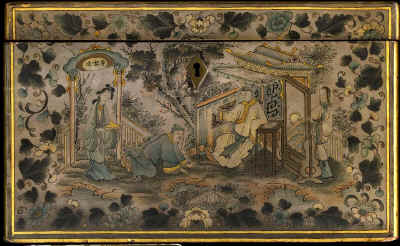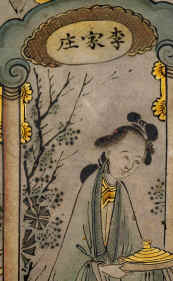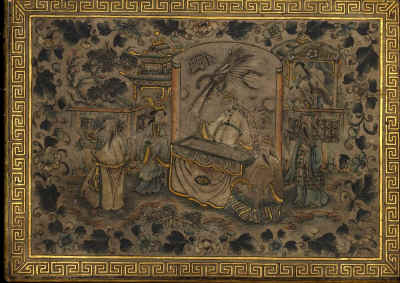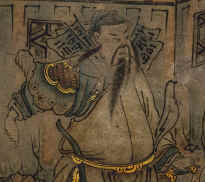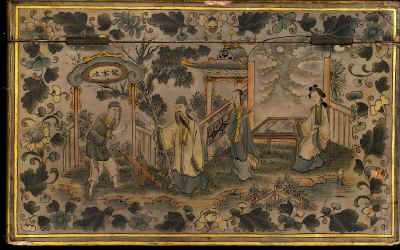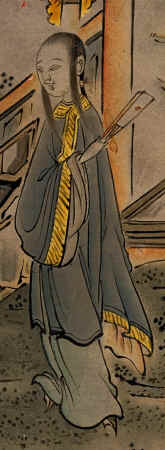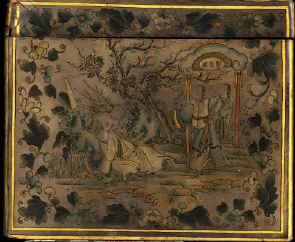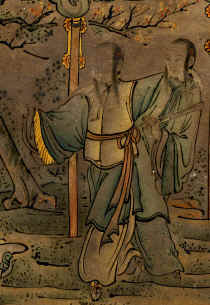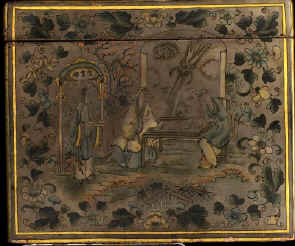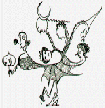 |
ANTIQUE BOXES
at the Sign of the Hygra 2 Middleton Road London E8 4BL Tel: 00 44 (0)20 7254 7074 email: boxes@hygra.com |
1760 -1900 by ANTIGONE Tea Caddies and Tea |
| Tea Caddies and Tea |
Home |
Contents |
Up |
Thumbs |
Tea Chest in colored lacquer. Circa 1800.
| A tea
chest in lacquer
completely covered in white gold and painted in very fine black lines
and colored lacquer.
The decoration is not in the fashion of export lacquerware, but in the ancient tradition of Chinese brush and ink sketches. The painting is done with assured minimal strokes. The colors have a translucent quality. The presence of calligraphy points to the painter being a skilled and learned man. There are scenes of Chinese life framed with representations of flowers all of which carry symbolic significance. Size: 10.4" wide by 7.4" deep by 6.2" high. |
| Front: Click on image to enlarge. |
The Chinese characters above the entrance read: Zhuang Jia Li; Li = plum - Tang Dynasty. The woman behind the screen could be the infamous Yangguifei - the "fragrant concubine". She was said to be responsible for the downfall of the Tang Dynasty. The kowtowing (head to floor) man is Anlushan, who started a rebellion in 755 AD. He was of Turkish origin and had risen through the military ranks and was a favorite of Yangguifei - the "fragrant concubine". |
| Top: Click on image to enlarge. | Click on images to enlarge.
This looks like a scene from the Peking Opera, which utilizes symbols to communicate rank and position.
The scene suggests the Emperor with the symbolic dragon on the screen behind him, a General approaching, an advising scholar, and a watching lady. The auspicious characters on the banners behind the figure on the left are forms of fu meaning "blessings" and "happiness". |
| Back: Click on image to enlarge. |
The Chinese characters above the entrance read: Long Jia Zhuang; Long =Dragon The residence of the Dragon Family. The Dragon and the Tiger are the emblems of Water and Fire and were used to represent the Emperor. The beard is an artistic device denoting an important scholar or sage.
|
| Side: Click on image to enlarge. |
The Chinese characters above the entrance read: Zheng Hua Yuan= The Zheng Flower Gardens. Zheng was a feudal state which flourished around the 8th C AD. It was noted for its "Lewd songs".
|
| Side: Click on image to enlarge. |
The Chinese characters above the entrance read: Hu Shu Fung; Hu = Tiger. The Chinese Character on the hat of the left hand seated figure is Hu - Tiger. He also has the symbol of longevity. |
| Inside the Chest is in red lacquer. The white metal liner is missing and has been replaced by two lift-out trays in beech wood, which have been designed to hold playing cards. |
